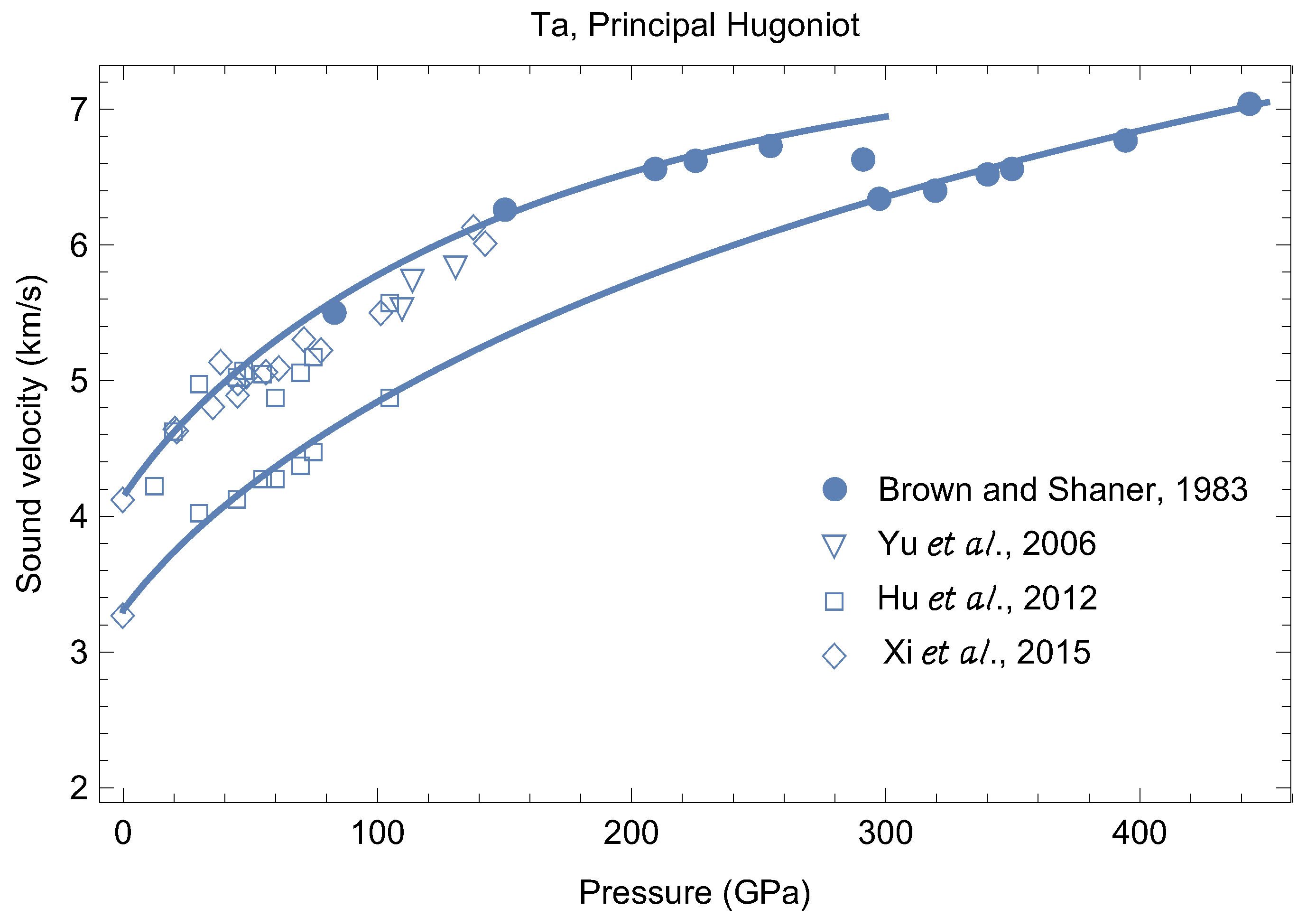Generalization of the Unified Analytic Melt-Shear Model to Multi-Phase Materials: Molybdenum as an Example
Abstract
:1. Introduction: Unified Analytic Melt-Shear Model
2. Molybdenum: An Example of a Multi-Phase Material
3. Generalization of the Unified Melt-Shear Model to Multi-Phase Materials
The Value of : Ultrahigh Density Limit
4. Generalized Melt-Shear Model for Molybdenum
Model Parameters for Mo
5. Comparison to Data
5.1. Cold Shear Modulus of bcc-Mo and fcc-Mo from VASP
5.2. bcc-fcc Phase Transition in Mo
5.3. Melting Curve of Mo
5.4. Thermoelastic Softening Parameter
6. Thermoelasticity Model of Molybdenum
Shear Modulus and Sound Velocities Along the Principal Hugoniot
7. The Phase Diagram of Molybdenum
8. Concluding Remarks
Author Contributions
Funding
Acknowledgments
Conflicts of Interest
Appendix A. Is There a Solid-Solid Transition on the Mo Hugoniot?
Appendix B. Unified Analytic Melt-Shear Models for Ta and W
Appendix B.1. Tantalum
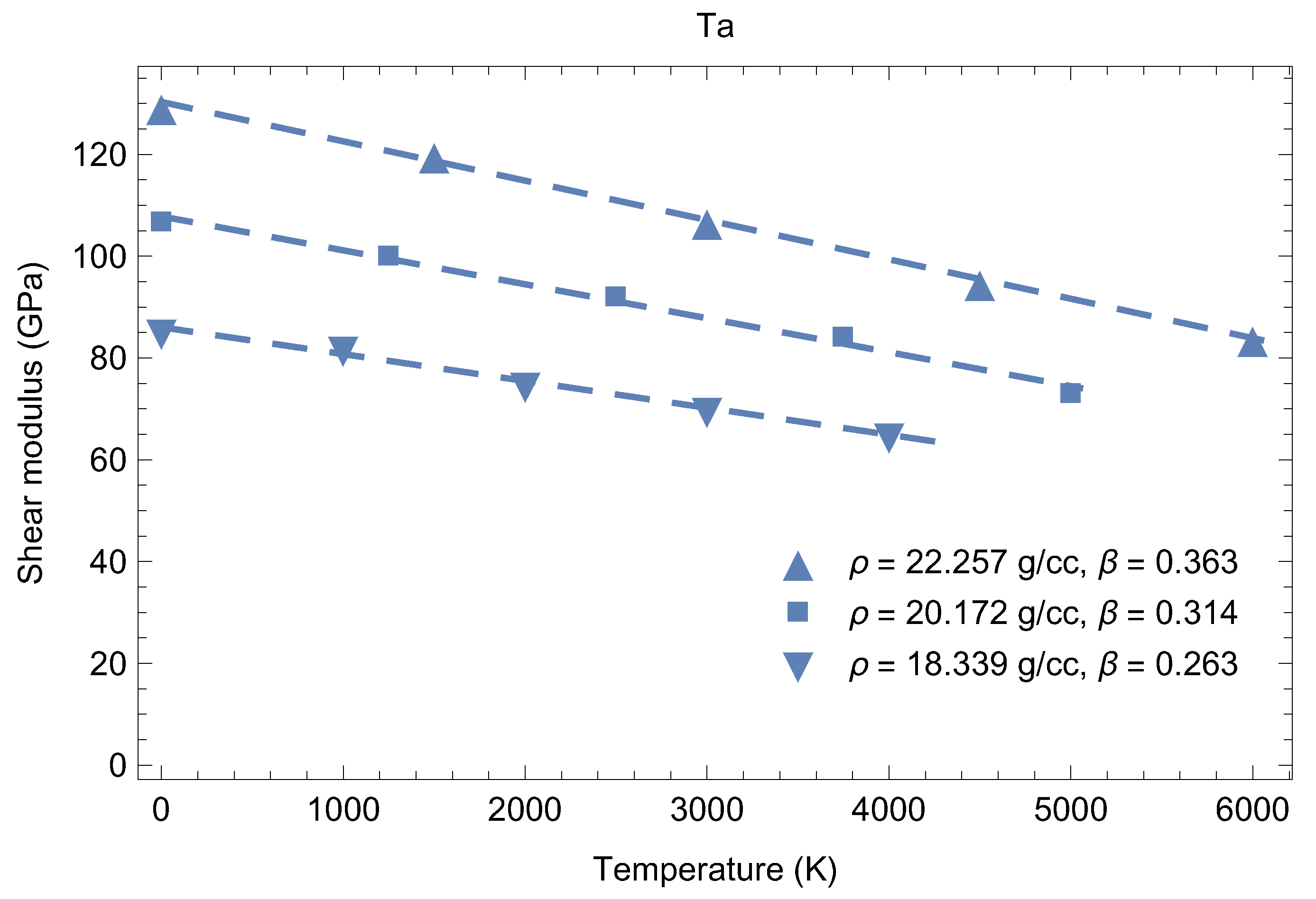
Appendix B.2. Tungsten
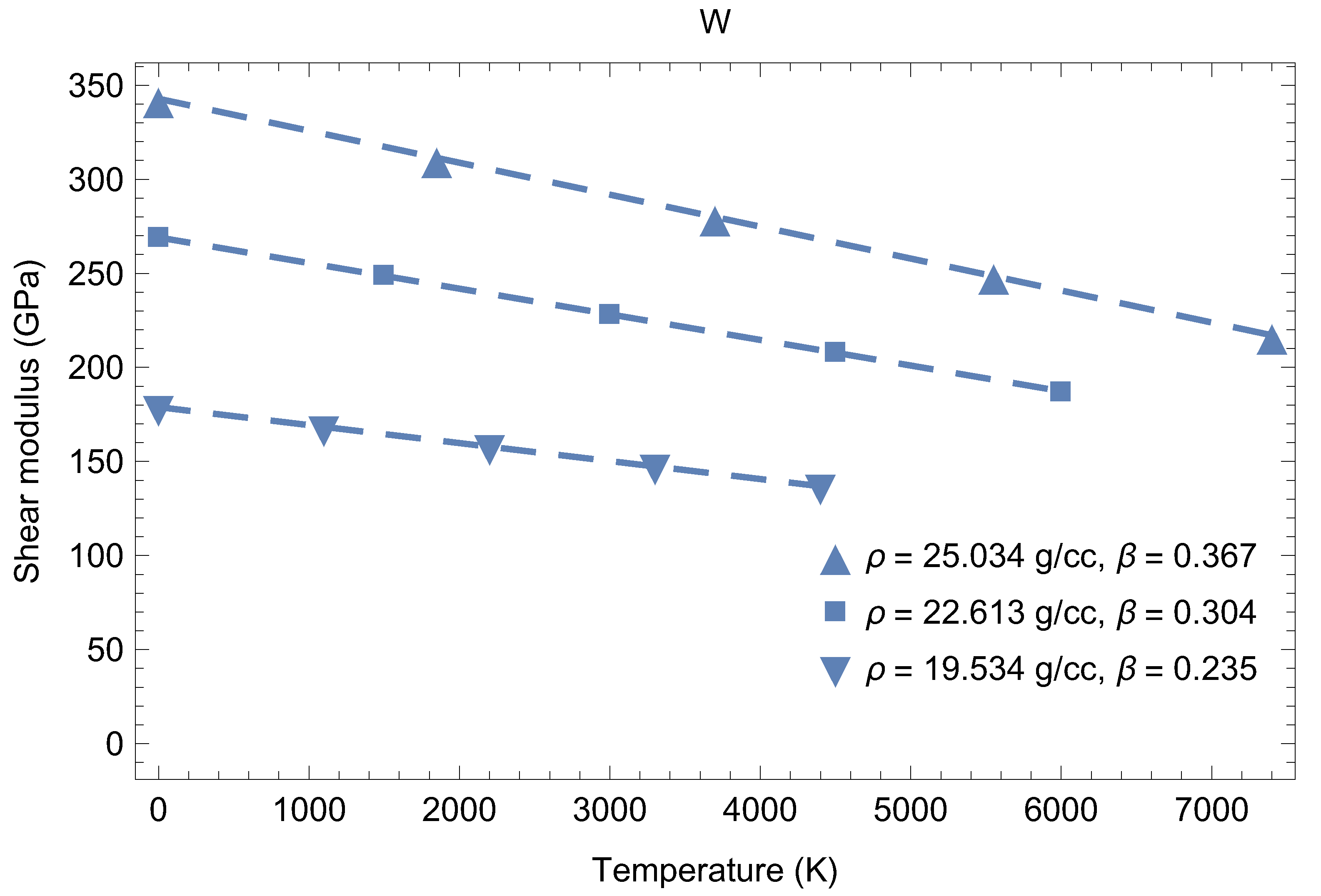
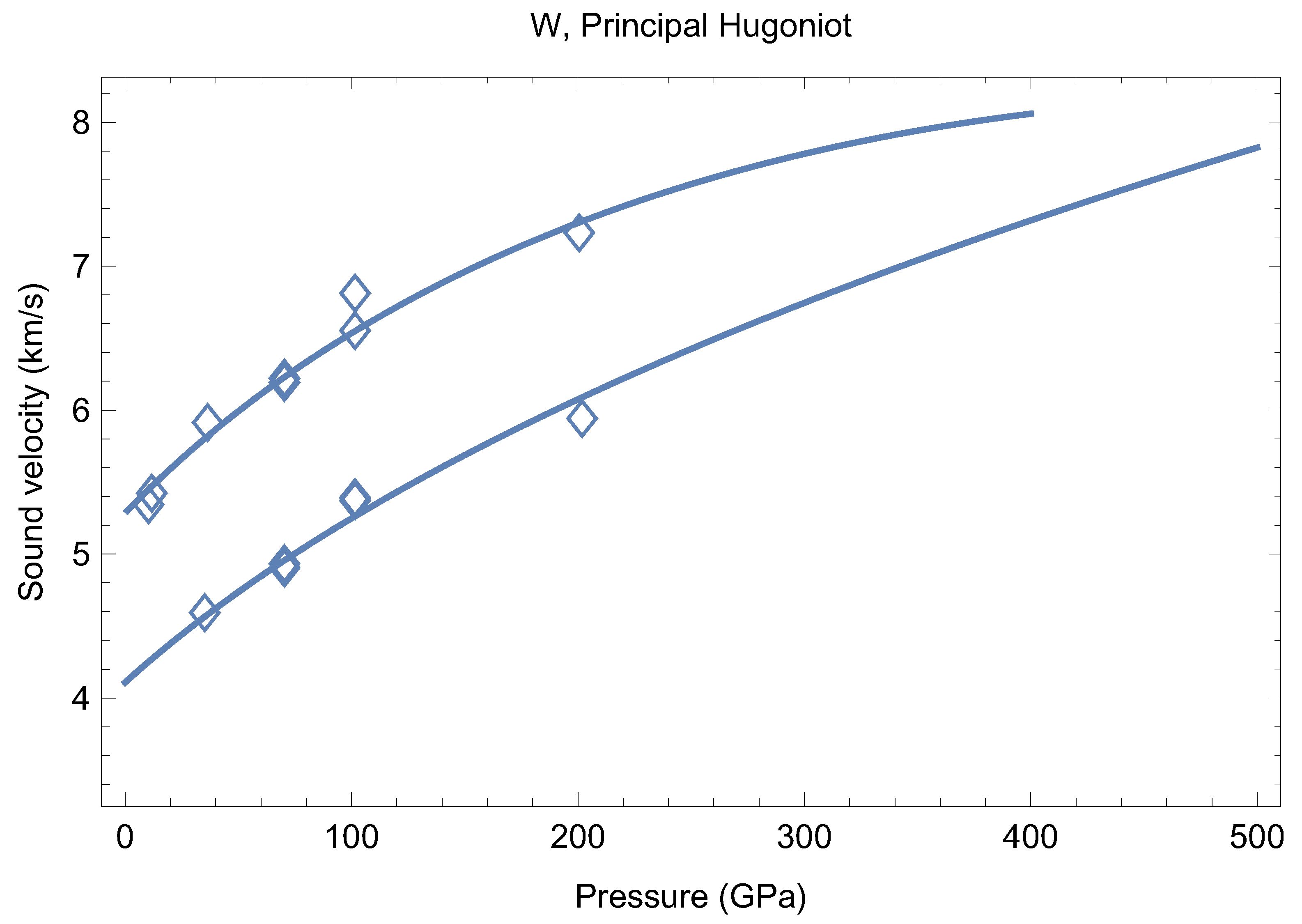
References
- Burakovsky, L.; Greeff, C.W.; Preston, D.L. Analytic model of the shear modulus at all temperatures and densities. Phys. Rev. B 2003, 67, 094107. [Google Scholar] [CrossRef]
- Burakovsky, L.; Preston, D.L. Analytic model of the Grüneisen parameter all densities. J. Phys. Chem. Sol. 2004, 65, 1581. [Google Scholar] [CrossRef]
- Young, D.A. Phase Diagrams of the Elements; University of California Press: Berkeley, CA, USA, 1991. [Google Scholar]
- Burakovsky, L.; Preston, D.L. Analysis of dislocation mechanism for melting of elements. Solid State Commun. 2000, 115, 341. [Google Scholar] [CrossRef]
- Burakovsky, L.; Preston, D.L.; Silbar, R.R. Melting as a dislocation-mediated phase transition. Phys. Rev. B 2000, 61, 15011. [Google Scholar] [CrossRef]
- Preston, D.L.; Wallace, D.C. A model of the shear modulus. Solid State Commun. 1992, 81, 277. [Google Scholar] [CrossRef]
- Hixson, R.S.; Boness, D.A.; Shaner, J.W.; Moriarty, J.A. Acoustic velocities and phase transitions in molybdenum under strong shock compression. Phys. Rev. Lett. 1989, 62, 637. [Google Scholar] [CrossRef]
- Nguyen, J.H.; Akin, M.C.; Chau, R.; Fratanduono, D.E.; Ambrose, W.P.; Fat’yanov, O.V.; Asimow, P.D.; Holmes, N.C. Molybdenum sound velocity and shear modulus softening under shock compression. Phys. Rev. B 2014, 89, 174109. [Google Scholar] [CrossRef]
- Wang, J.; Coppari, F.; Smith, R.F.; Eggert, J.H.; Lazicki, A.E.; Fratanduono, D.E.; Rygg, J.R.; Boehly, T.R.; Collins, G.W.; Duffy, T.S. X-ray diffraction of molybdenum under shock compression to 450 GPa. Phys. Rev. B 2015, 92, 174114. [Google Scholar] [CrossRef]
- Ruoff, A.L.; Xia, H.; Xia, Q. The effect of a tapered aperture on X-ray diffraction from a sample with a pressure gradient: Studies on three samples with a maximum pressure of 560 GPa. Rev. Sci. Instrum. 1992, 6, 4342–4348. [Google Scholar] [CrossRef]
- Wang, J.; Coppari, F.; Smith, R.F.; Eggert, J.H.; Lazicki, A.E.; Fratanduono, D.E.; Rygg, J.R.; Boehly, T.R.; Collins, G.W.; Duffy, T.S. X-ray diffraction of molybdenum under ramp compression to 1 TPa. Phys. Rev. B 2016, 94, 104102. [Google Scholar] [CrossRef]
- Belonoshko, A.B.; Burakovsky, L.; Chen, S.P.; Johansson, B.; Mikhaylushkin, A.S.; Preston, D.L.; Simak, S.I.; Swift, D.C. Molybdenum at high pressure and temperature: Melting from another solid phase. Phys. Rev. Lett. 2008, 100, 135701. [Google Scholar] [CrossRef] [PubMed]
- Cazorla, C.; Alfè, D.; Gillan, M.J. Comment on “Molybdenum at high pressure and temperature: Melting from another solid phase”. Phys. Rev. Lett. 2008, 101, 049601. [Google Scholar] [CrossRef] [PubMed]
- Mikhaylushkin, A.S.; Simak, S.I.; Burakovsky, L.; Chen, S.P.; Johansson, B.; Preston, D.L.; Swift, D.C.; Belonoshko, A.B. Mikhaylushkin et al. Reply. Phys. Rev. Lett. 2008, 101, 049602. [Google Scholar] [CrossRef]
- Cai, L.-C.; Zeng, Z.-Y.; Zhang, X.-L.; Hu, J.-B. Experimental research on high pressure phase transitions of Mo and Ta. EPJ Web Conf. 2010, 8, 00028. [Google Scholar] [CrossRef]
- Lukinov, T.; Simak, S.I.; Belonoshko, A.B. Sound velocity in shock compressed molybdenum obtained by ab initio molecular dynamics. Phys. Rev. B 2015, 92, 060101. [Google Scholar] [CrossRef]
- Zeng, Z.-Y.; Hu, C.-E.; Zhang, W.; Niu, Z.-W.; Cai, L.-C. Dynamical stability of Mo under high pressure and high temperature. J. Appl. Phys. 2014, 116, 133518. [Google Scholar] [CrossRef]
- Krasilnikov, O.M.; Belov, M.P.; Lugovskoy, A.V.; Mosyagin, I.Y.; Vekilov, Y.K. Elastic properties, lattice dynamics and structural transitions in molybdenum at high pressures. Comput. Mater. Sci. 2014, 81, 313–318. [Google Scholar] [CrossRef]
- Christensen, N.E.; Ruoff, A.L.; Rodriguez, C.O. Pressure strengthening: A way to multimegabar static pressures. Phys. Rev. B 1995, 52, 9121. [Google Scholar] [CrossRef]
- Belonoshko, A.B.; Simak, S.I.; Kochetov, A.E.; Johansson, B.; Burakovsky, L.; Preston, D.L. High-pressure melting of molybdenum. Phys. Rev. Lett. 2004, 92, 195701. [Google Scholar] [CrossRef]
- Wang, B.; Zhang, G.B.; Wang, Y.X. Predicted crystal structures of molybdenum under high pressure. J. Alloys Compd. 2013, 556, 116–120. [Google Scholar] [CrossRef]
- Sin’ko, G.V.; Smirnov, N.A. Relative stability and elastic properties of hcp, bcc, and fcc beryllium under pressure. Phys. Rev. B 2005, 71, 214108. [Google Scholar]
- Robert, G.; Sollier, A.; Legrand, P. Multiphase equation of state and strength properties of beryllium from ab initio and quantum molecular dynamics calculations. AIP Conf. Proc. 2007, 955, 97–110. [Google Scholar]
- Errandonea, D.; Boehler, R.; Ross, M. Comment on “Molybdenum sound velocity and shear modulus softening under shock compression”. Phys. Rev. B 2015, 92, 026101. [Google Scholar] [CrossRef]
- Cazorla, C.; Gillan, M.J.; Taioli, S.; Alfè, D. Melting curve and Hugoniot of molybdenum up to 400 GPa by ab initio simulations. J. Phys. Conf. Ser. 2008, 121, 012009. [Google Scholar] [CrossRef]
- Zhang, X.; Liu, Z.; Jin, K.; Xi, F.; Yu, Y.; Tan, Y.; Dai, C.; Cai, L. Solid phase stability of molybdenum under compression: Sound velocity measurements and first-principles calculations. J. Appl. Phys. 2015, 117, 054302. [Google Scholar] [CrossRef]
- Foata-Prestavoine, M.; Nadal, G.R.M.-H.; Bernard, S. First-principles study of the relations between the elastic constants, phonon dispersion curves, and melting temperatures of bcc Ta at pressures up to 1000 GPa. Phys. Rev. B 2007, 76, 104104. [Google Scholar] [CrossRef]
- Burakovsky, L.; Preston, D.L.; Wang, Y. Cold shear modulus and Grüneisen parameter at all densities. Solid State Commun. 2004, 132, 151–156. [Google Scholar] [CrossRef]
- Burakovsky, L.; Preston, D.L. Unified analyic model of the Grüneisen parameter, melting temperature, and shear modulus. Recent Res. Dev. Phys. 2004, 5, 193. [Google Scholar]
- Guinan, M.; Steinberg, D. A simple approach to extrapolating measured polycrystalline shear moduli to very high pressure. J. Phys. Chem. Sol. 1975, 36, 829. [Google Scholar] [CrossRef]
- Burakovsky, L.; Preston, D.L. Generalized Guinan-Steinberg formula for the shear modulus at all pressures. Phys. Rev. B 2005, 71, 184118. [Google Scholar] [CrossRef]
- Burakovsky, L.; Preston, D.L. Shear modulus at all pressures: Generalized Guinan-Steinberg formula. J. Phys. Chem. Sol. 2006, 67, 1930. [Google Scholar] [CrossRef]
- A (More) Physically Based First Approximation for Electron Probe Quantification. Available online: http://epmalab.uoregon.edu/UCB_EPMA/Physically.htm (accessed on 6 February 2019).
- Cazorla, C.; Alfè, D.; Gillan, M.J. Melting properties of a simple tight-binding model of transition metals. I. The region of half-filled d-band. J. Chem. Phys. 2009, 130, 174707. [Google Scholar] [CrossRef] [PubMed]
- Errandonea, D.; Schwager, B.; Ditz, R.; Gessmann, C.; Boehler, R.; Ross, M. Systematics of transition-metal melting. Phys. Rev. B 2001, 63, 132104. [Google Scholar] [CrossRef]
- Santamaría-Pérez, D.; Ross, M.; Errandonea, D.; Mukherjee, G.D.; Mezouar, M.; Boehler, R. X-ray diffraction measurements of Mo melting to 119 GPa and the high pressure phase diagram. J. Chem. Phys. 2009, 130, 124509. [Google Scholar]
- Hrubiak, R.; Meng, Y.; Shen, G. Microstructures define melting of molybdenum at high pressures. Nat. Commun. 2017, 8, 14562. [Google Scholar] [CrossRef] [PubMed]
- Liu, W.; Liu, Q.; Whitaker, M.L.; Zhao, Y.; Li, B. Experimental and theoretical studies on the elasticity of molybdenum to 12 GPa. J. Appl. Phys. 2009, 106, 043506. [Google Scholar] [CrossRef]
- Hixson, R.S.; Winkler, M.A. Thermophysical properties of molybdenum and rhenium. Int. J. Thermophys. 1992, 13, 477–487. [Google Scholar] [CrossRef]
- Shaner, J.W.; Gathers, G.R.; Minichino, C. Thermophysical properties of liquid tantalum and molybdenum. High Temp.-High Pres. 1977, 9, 331–343. [Google Scholar]
- Kresseg, G.; Vienna. Private communication, 2017.
- Söderlind, P.; Eriksson, O.; Wills, J.M.; Boring, A.M. Theory of elastic constants of cubic transition metals and alloys. Phys. Rev. B 1993, 48, 5844. [Google Scholar]
- Zhang, G.-M.; Liu, H.-F.; Duan, S.-Q. Melting property of Mo at high pressure from molecular dynamics simulations. Chin. J. High Pres. Phys. 2008, 22, 53. [Google Scholar]
- Cazorla, C.; Gillan, J.; Taioli, S.; Alfè, D. Ab initio melting curve of molybdenum by the phase coexistence method. J. Chem. Phys. 2007, 126, 194502. [Google Scholar] [CrossRef] [PubMed]
- For the detailed description of the Z method implemented with VASP, see Burakovsky, L.; Burakovsky, N.; Preston, D.L. Ab initio melting curve of osmium. Phys. Rev. B 2015, 92, 174105.
- Kinslow, R. (Ed.) High-Velocity Impact Phenomena; Academic Press: New York, NY, USA, 1970; Appendix E; p. 542. [Google Scholar]
- Hixson, R.S.; Fritz, J.N. Shock compression of tungsten and molybdenum. J. Appl. Phys. 1992, 71, 1721. [Google Scholar] [CrossRef]
- Burakovsky, L.; Chen, S.P.; Preston, D.L.; Sheppard, D.G. Z methodology for phase diagram studies: platinum and tantalum as examples. J. Phys. Conf. Ser. 2014, 500, 162001. [Google Scholar] [CrossRef]
- Cazorla, C.; Alfè, D.; Gillan, M.J. Constraints on the phase diagram of molybdenum from first-principles free-energy calculations. Phys. Rev. B 2012, 85, 064113. [Google Scholar] [CrossRef]
- Zeng, Z.-Y.; Hu, C.-E.; Liu, X.; Cai, L.-C.; Jing, F.-Q. Ab initio study of acoustic velocities in molybdenum under high pressure and high temperature. Appl. Phys. Lett. 2011, 99, 191906. [Google Scholar] [CrossRef]
- Davis, J.-P.; Brown, J.L.; Knudson, M.D.; Lemke, W. Analysis of shockless dynamic compression data on solids to multi-megabar pressures: Application to tantalum. J. Appl. Phys. 2014, 116, 204903. [Google Scholar] [CrossRef]
- Eggert, J.H.; Smith, R.F.; Swift, D.C.; Rudd, R.E.; Fratanduono, D.E.; Braun, D.G.; Hawreliak, J.A.; McNaney, J.M.; Collins, G.W. Ramp compression of tantalum to 330 GPa. High Pres. Res. 2015, 35, 339–354. [Google Scholar] [CrossRef]
- Söderlind, P.; Moriarty, J.A. First-principles theory of Ta up to 10 Mbar pressure: Structural and mechanical properties. Phys. Rev. B 1998, 57, 10340. [Google Scholar]
- Yao, Y.; Klug, D.D. Stable structures of tantalum at high temperature and high pressure. Phys. Rev. B 2013, 88, 054102. [Google Scholar] [CrossRef]
- Grimvall, G.; Magyari-Köpe, B.; Ozoliņŝ, V.; Persson, K.A. Lattice instabilities in metallic elements. Rev. Mod. Phys. 2012, 84, 945. [Google Scholar] [CrossRef]
- Brown, J.M.; Shaner, J.W. Rarefaction Velocities in Shocked Tantalum and the High Pressure Melting Point. In Shock Waves in Condensed Matter-1983; Asay, J.R., Graham, R.A., Straub, G.K., Eds.; Elsevier: New York, NY, USA, 1984; Los Alamos Preprint LA-UR-83-2144; p. 91. [Google Scholar]
- Yu, Y.; Tan, H.; Hu, J.; Dai, C.; Chen, D. Measurements of sound velocities in shock-compressed tantalum and LY12 Al. Explos. Shock Waves 2006, 26, 486. [Google Scholar]
- Hu, J.; Dai, C.; Yu, Y.; Liu, Z.; Tan, Y.; Zhou, X.; Tan, H.; Cai, L.; Wu, Q. Sound velocity measurements of tantalum under shock compression in the 10-110GPa range. J. Appl. Phys. 2012, 111, 033511. [Google Scholar] [CrossRef]
- Xi, F.; Jin, K.; Cai, L.; Geng, H.; Tan, Y.; Li, J. Sound velocity of tantalum under shock compression in the 18-142 GPa range. J. Appl. Phys. 2015, 117, 185901. [Google Scholar] [CrossRef]
- Zhang, H.-Y.; Niu, Z.-W.; Cai, L.-C.; Chen, X.-R.; Xi, F. Ab initio dynamical stability of tungsten at high pressures and high temperatures. Comput. Mater. Sci. 2018, 144, 32–35. [Google Scholar] [CrossRef]
- Duffy, T.S.; Ahrens, T.J. Sound velocities at high pressure and temperature and their geophysical implications. J. Geophys. Res. B 1992, 97, 4503. [Google Scholar] [CrossRef]
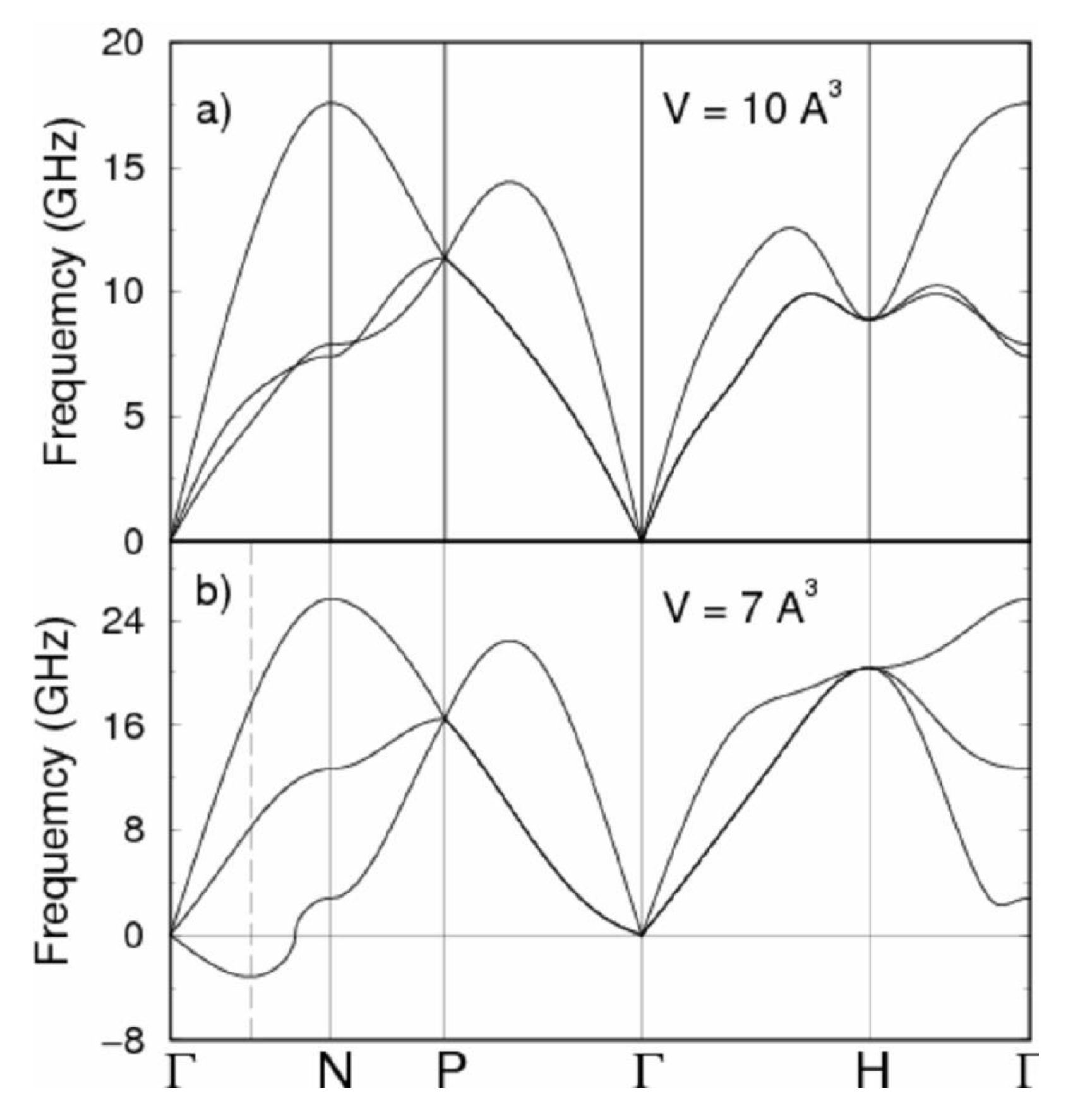
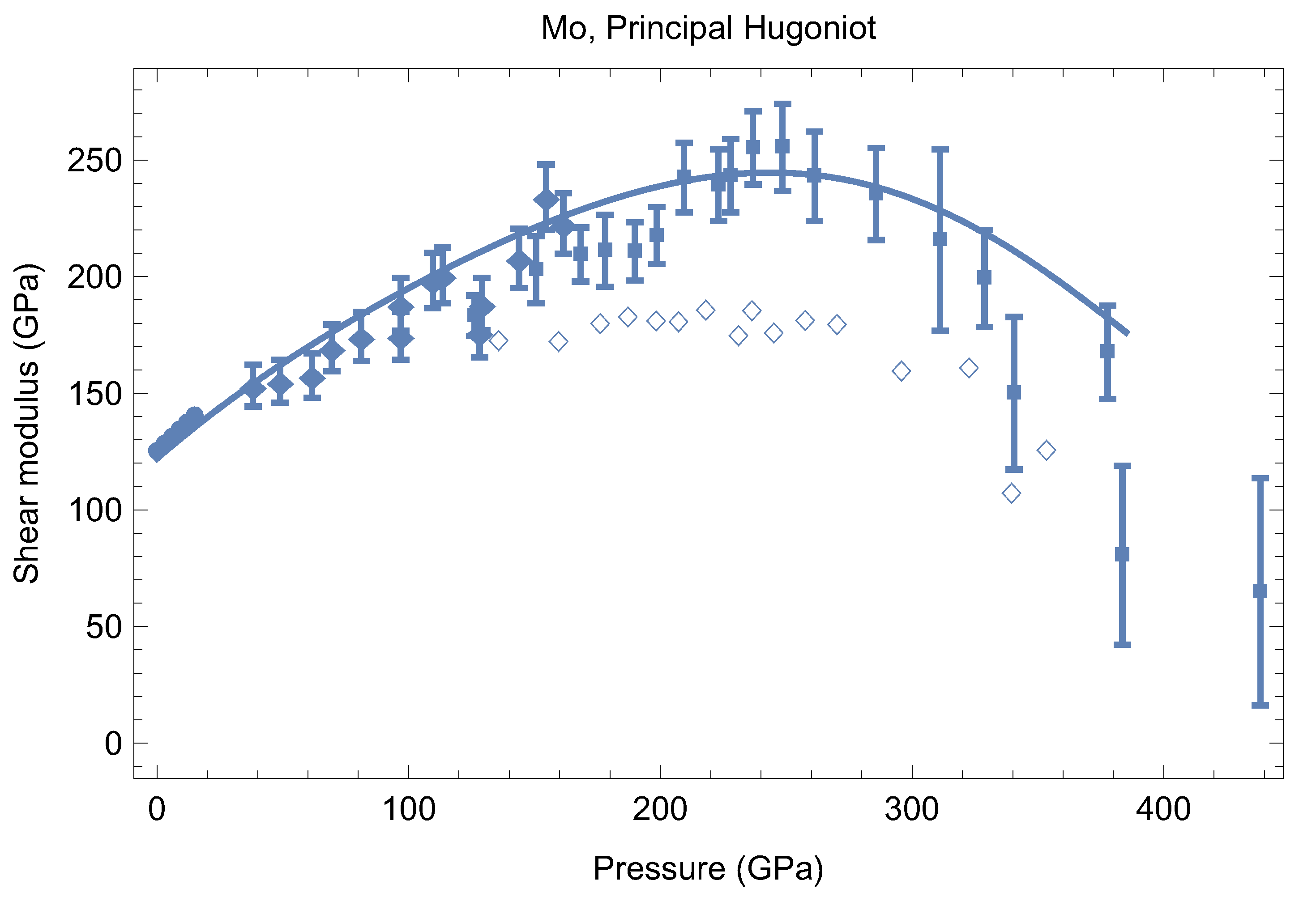
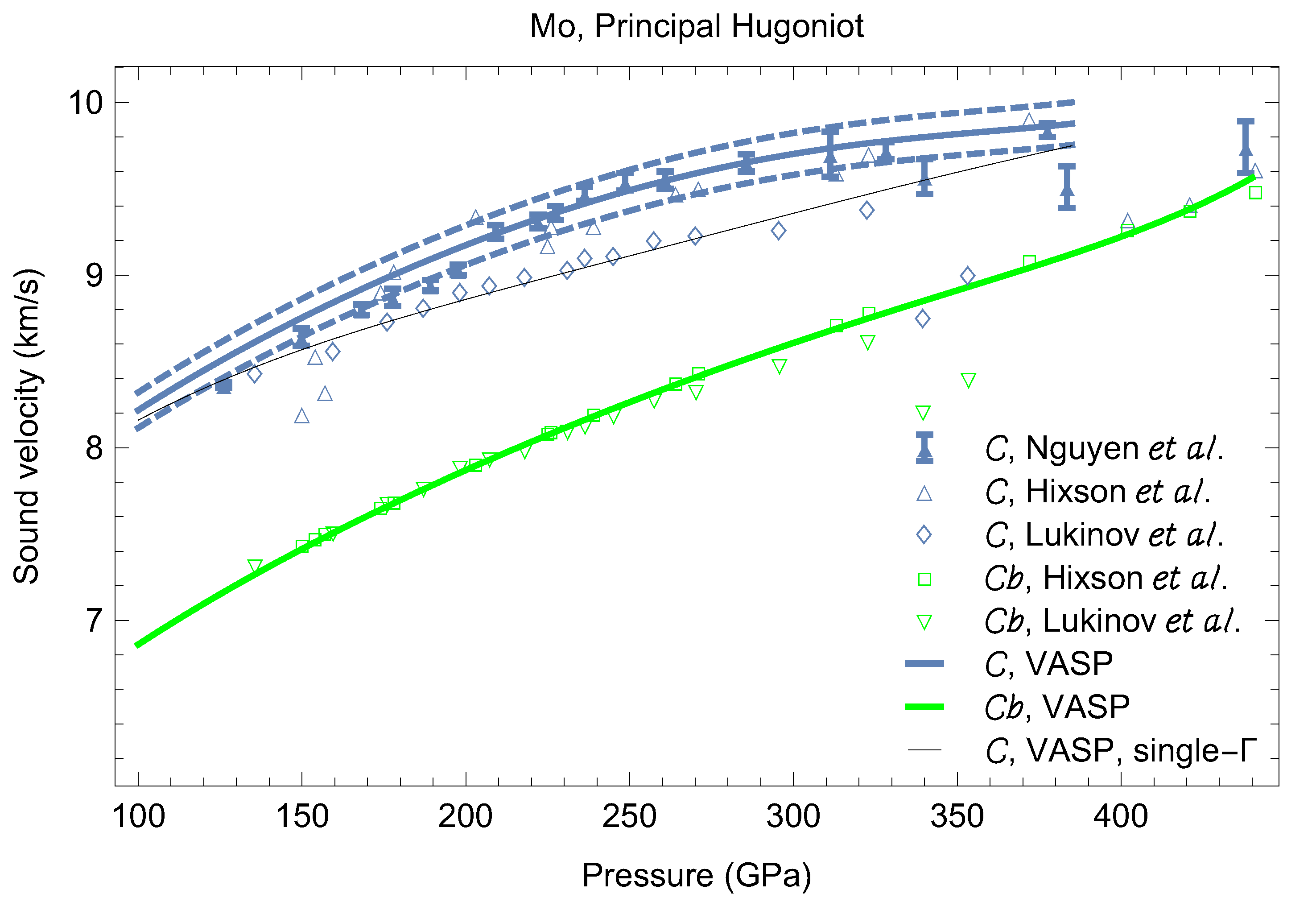
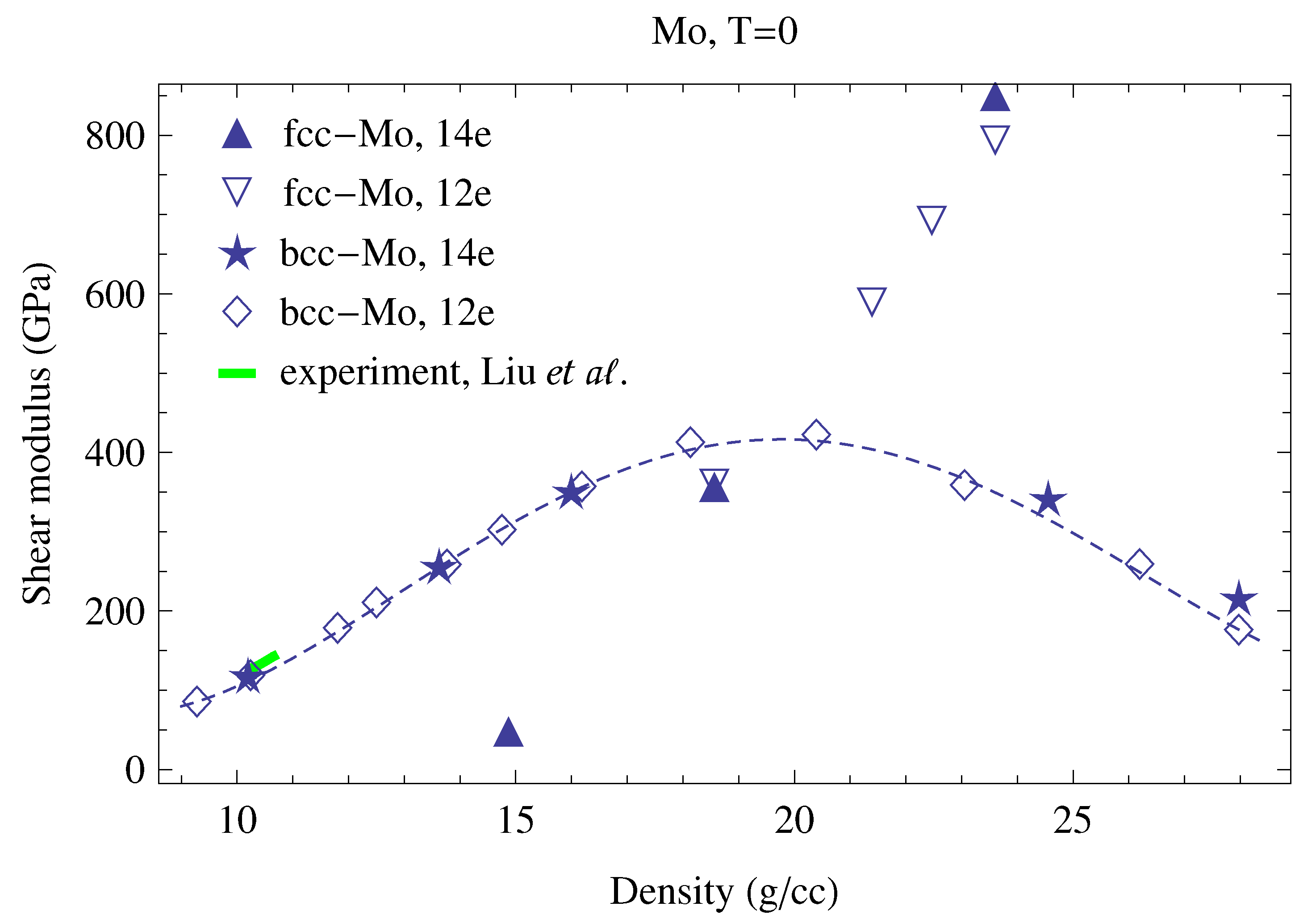
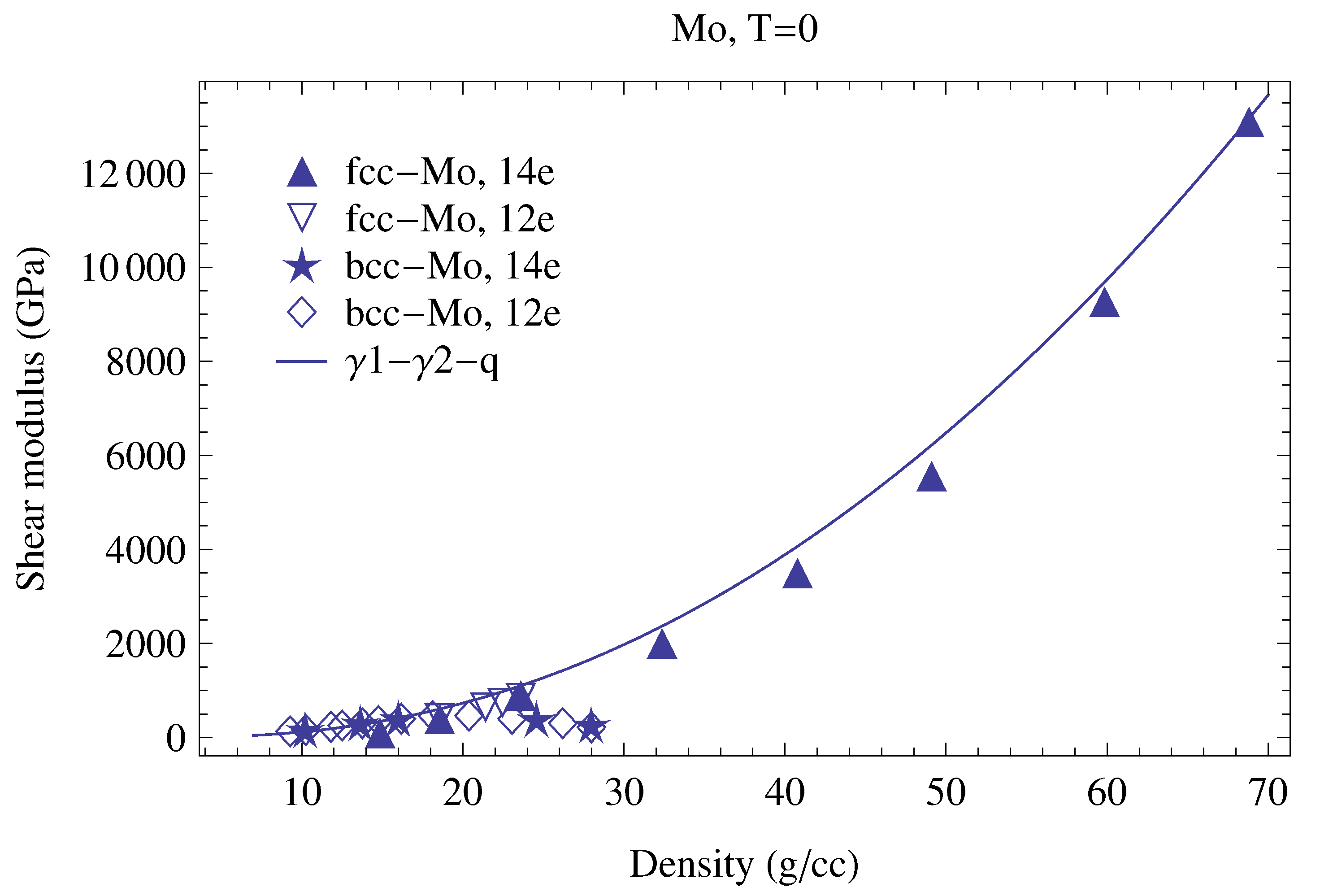
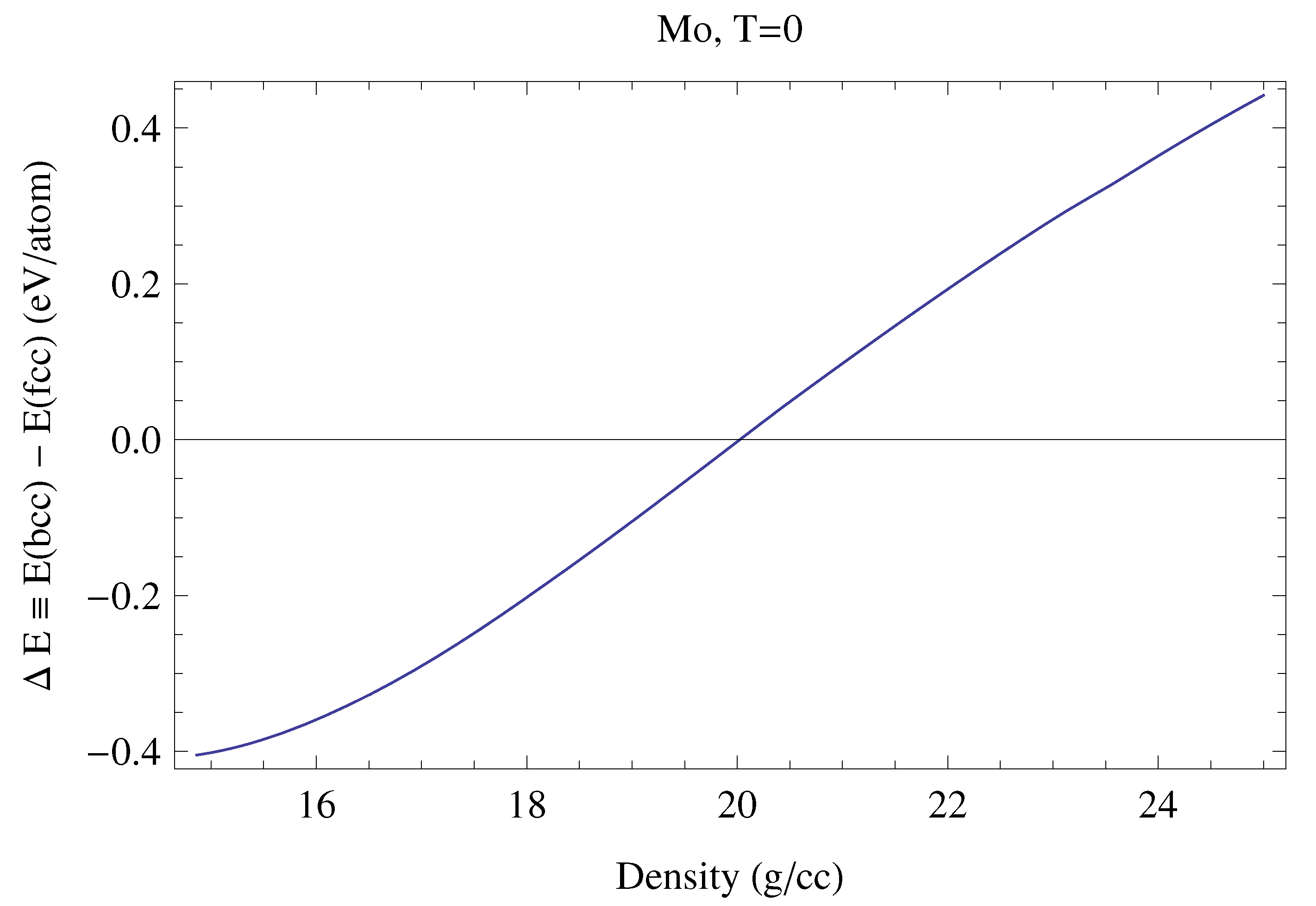

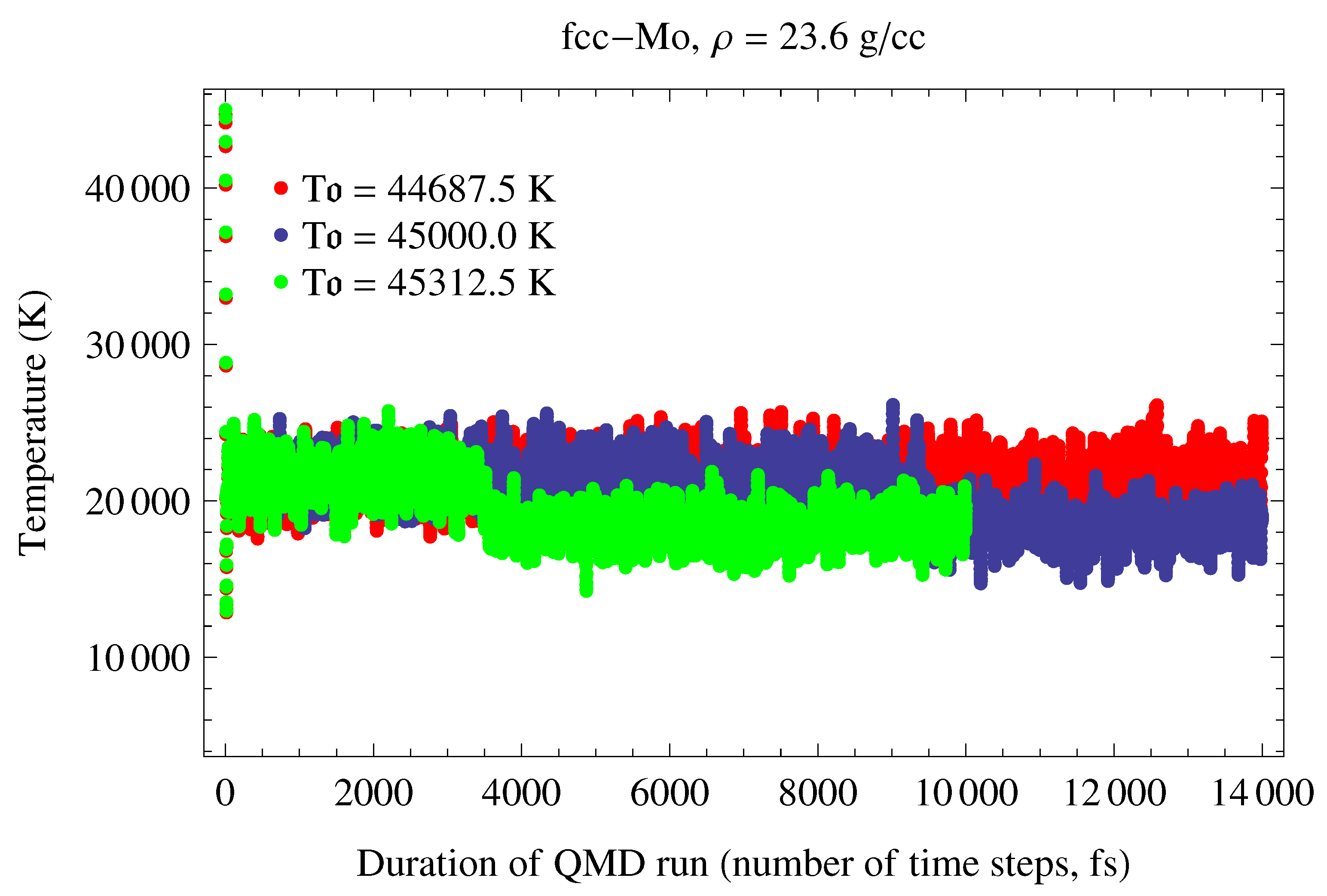
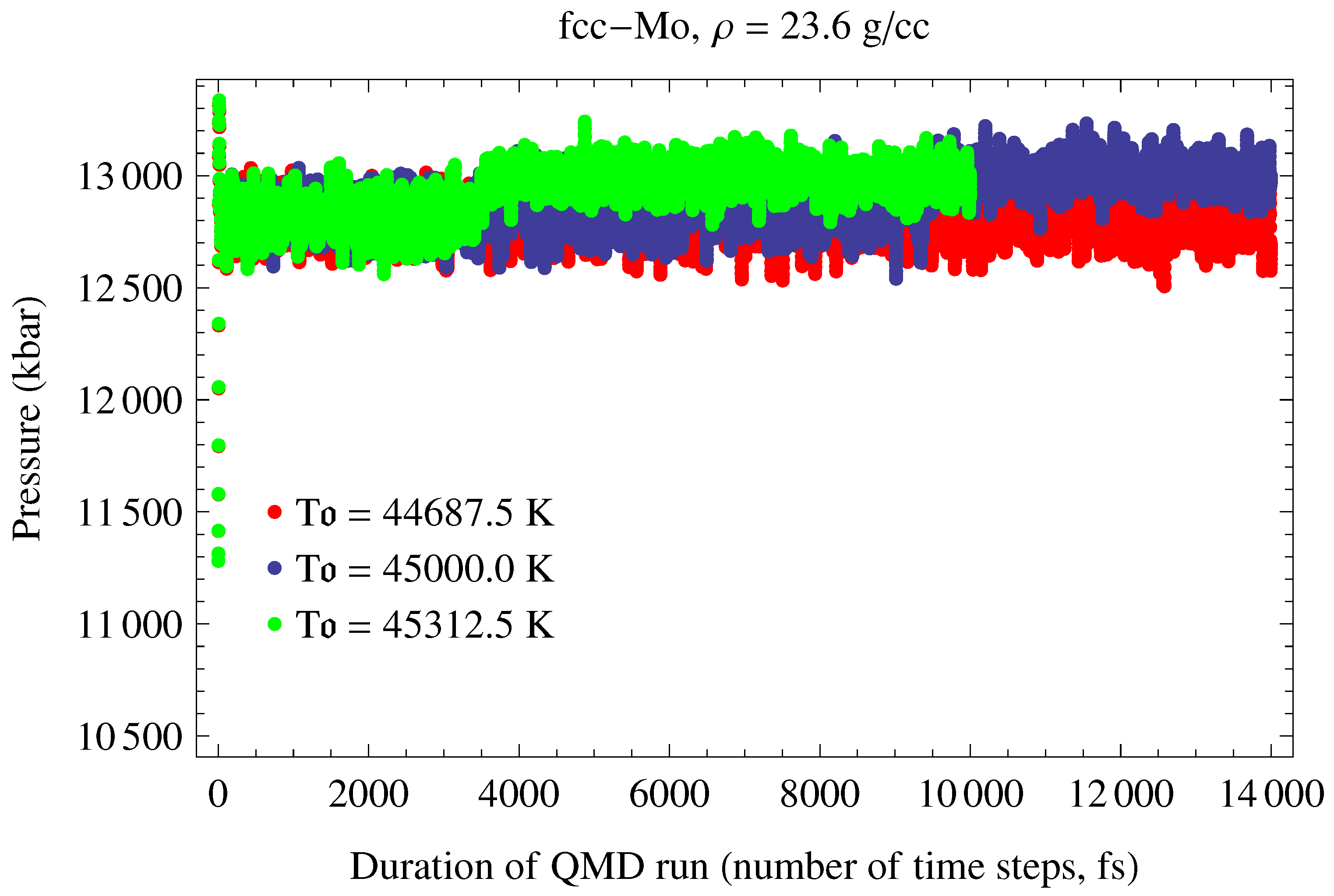
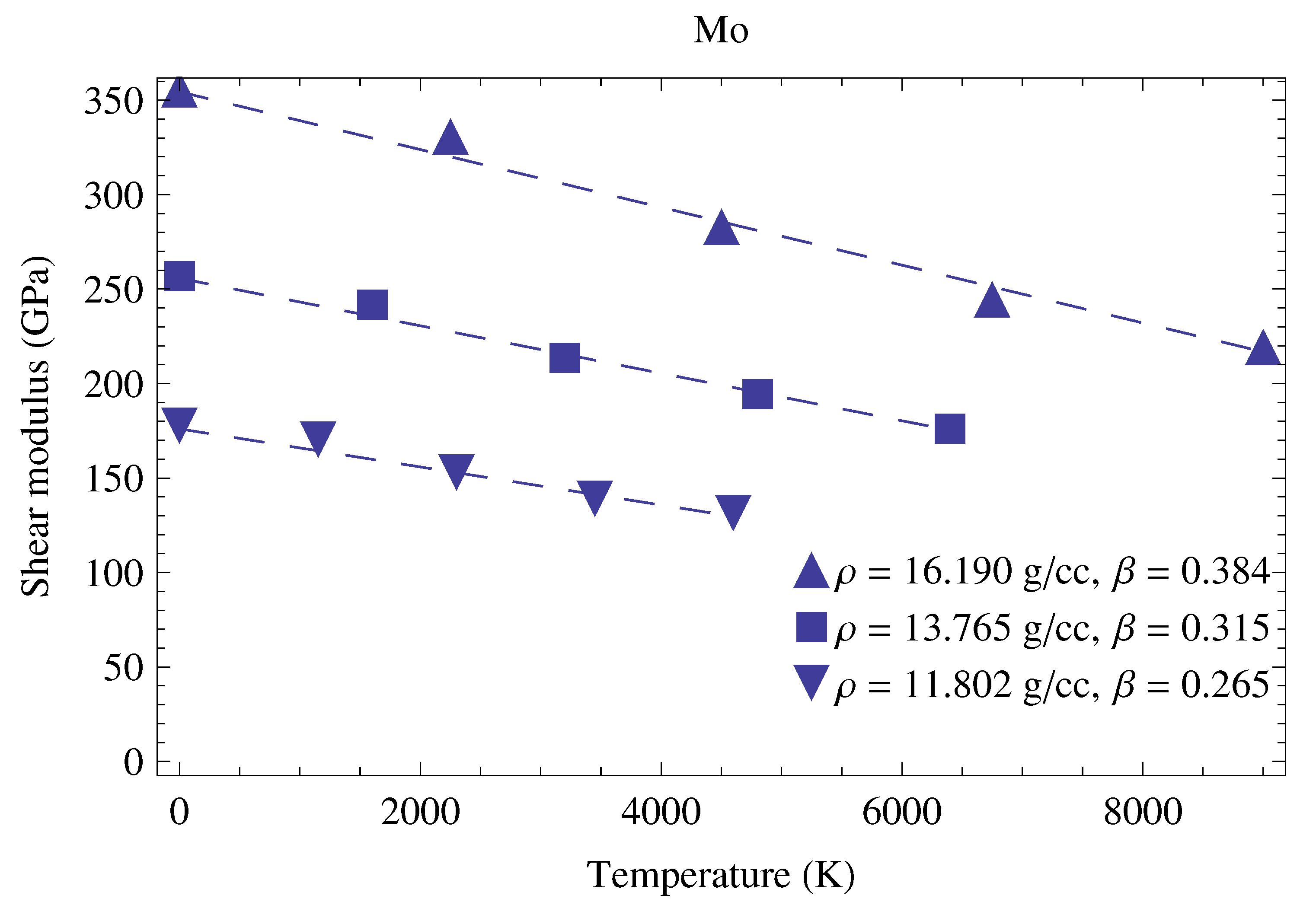
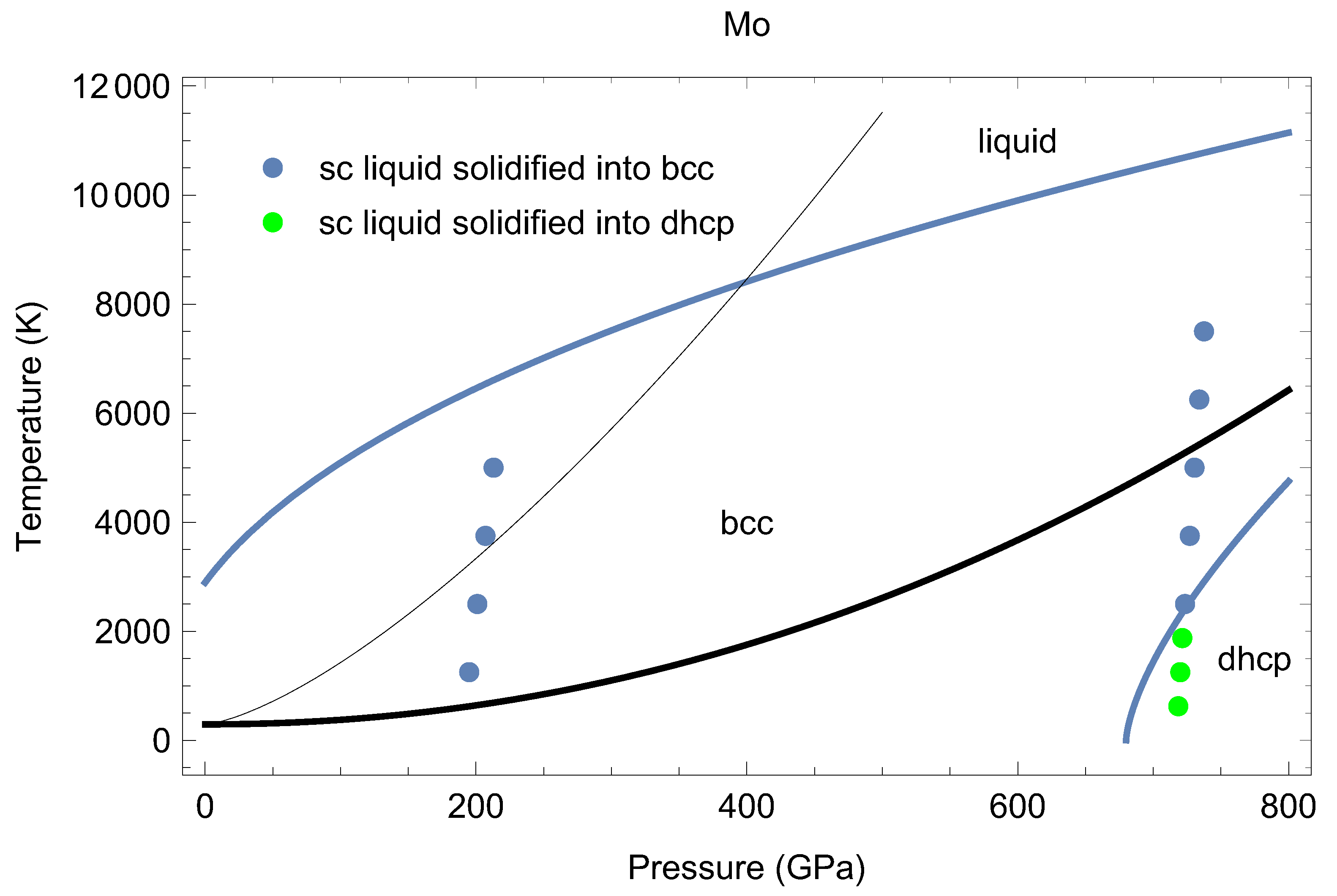
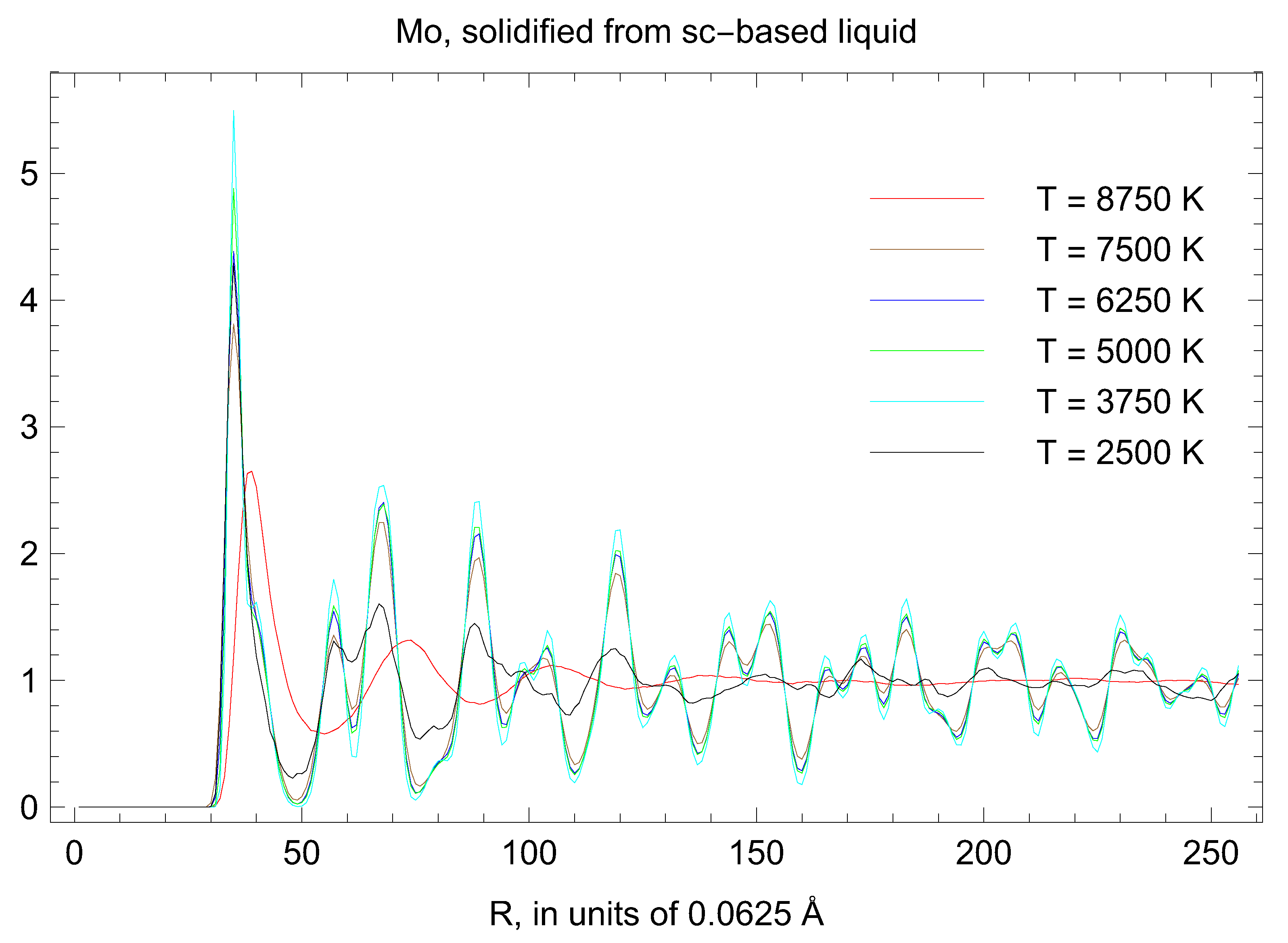

| Z | a | b | |||||||||||
|---|---|---|---|---|---|---|---|---|---|---|---|---|---|
| Mo | 42 | 2.11450 | 0.63 | −1.31 | 0.45 | −0.045 | 10.25 | 9.56 | 128.2 | 2896 | 0.23 | 0.0212 | 1.11 |
| Ta | 73 | 3.05670 | 1.0 | −6.6 | 3.0 | −3000 | 16.74 | 15.30 | 72.2 | 3290 | 0.23 | 0.0210 | 1.09 |
| W | 74 | 3.08456 | 0.84 | −5.8 | 1.5 | −11.1 | 19.31 | 17.96 | 163.4 | 3695 | 0.23 | 0.0211 | 1.07 |
© 2019 by the authors. Licensee MDPI, Basel, Switzerland. This article is an open access article distributed under the terms and conditions of the Creative Commons Attribution (CC BY) license (http://creativecommons.org/licenses/by/4.0/).
Share and Cite
Burakovsky, L.; Luscher, D.J.; Preston, D.; Sjue, S.; Vaughan, D. Generalization of the Unified Analytic Melt-Shear Model to Multi-Phase Materials: Molybdenum as an Example. Crystals 2019, 9, 86. https://doi.org/10.3390/cryst9020086
Burakovsky L, Luscher DJ, Preston D, Sjue S, Vaughan D. Generalization of the Unified Analytic Melt-Shear Model to Multi-Phase Materials: Molybdenum as an Example. Crystals. 2019; 9(2):86. https://doi.org/10.3390/cryst9020086
Chicago/Turabian StyleBurakovsky, Leonid, Darby Jon Luscher, Dean Preston, Sky Sjue, and Diane Vaughan. 2019. "Generalization of the Unified Analytic Melt-Shear Model to Multi-Phase Materials: Molybdenum as an Example" Crystals 9, no. 2: 86. https://doi.org/10.3390/cryst9020086
APA StyleBurakovsky, L., Luscher, D. J., Preston, D., Sjue, S., & Vaughan, D. (2019). Generalization of the Unified Analytic Melt-Shear Model to Multi-Phase Materials: Molybdenum as an Example. Crystals, 9(2), 86. https://doi.org/10.3390/cryst9020086






